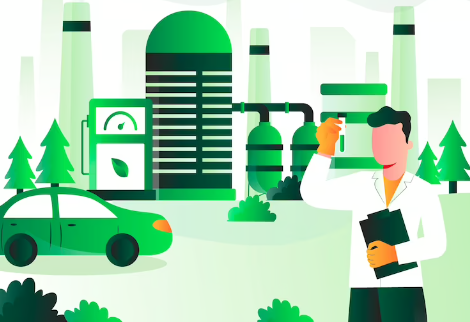The transition towards a more sustainable and environmentally responsible energy future has led to a growing interest in second-generation bioethanol (2G bioethanol). Therefore, as a cleaner and more efficient alternative to traditional fossil fuels, 2G bioethanol holds tremendous promise. However, its widespread adoption depends not only on technological advancements but also on the regulatory frameworks that support its development and implementation. In this blog post, we will explore the regulatory framework for 2G bioethanol.
As the world confronts the pressing challenges of climate change and the need for more sustainable energy sources, 2G bioethanol has emerged as a promising solution. Agricultural residues and forest biomass are commonly used as feedstocks for second-generation bioethanol, which can reduce greenhouse gas emissions and fossil fuel reliance significantly. However, the journey to a cleaner energy future requires navigating a complex web of regulatory frameworks. In this blog, we will explore the regulatory landscape governing 2G bioethanol and its implications on the path to a more sustainable energy sector.
The Need for Regulatory Framework of 2G Bioethanol
2G bioethanol, as a cleaner alternative to traditional fossil fuels, is integral to reducing greenhouse gas emissions. And thus mitigating the effects of climate change. Regulatory frameworks are necessary to:
Ensure Environmental Sustainability:
Regulations are crucial for ensuring production. Thus, the use of 2G bioethanol are environmentally responsible and minimizes adverse impacts on ecosystems.
Promote Investment:
Mainly clear and stable regulations can encourage private and public investment in developing 2G bioethanol technologies and infrastructure.
Foster Market Growth:
Regulatory support can stimulate demand for 2G bioethanol by creating incentives for consumers, automakers, and therefore fuel suppliers too.
Establish Standards:
In order to meet certain standards by these industries, regulations help define quality, safety, and sustainability criteria.
Key Regulatory Framework Components of 2G Ethanol
Environmental Regulations:
- Emissions Standards:
Many countries have established emissions limits for the transportation sector, incentivizing low-carbon fuels like 2G bioethanol.
- Carbon Reduction Targets:
Regulatory bodies are setting ambitious targets for reducing carbon emissions, which can be achieved, in part, through using low-carbon biofuels.
Renewable Fuel Standards (RFS):
- Mandates:
Some regions have implemented RFS that require a certain percentage of renewable fuels in transportation fuels, thus encouraging the use of 2G bioethanol.
- Incentives:
Governments may incentivize fuel producers, especially those who blend bioethanol in compliance with RFS.
Incentive Programs
- Tax Credits: Governments often provide tax credits to encourage investment in 2G bioethanol production.
- Grants and Subsidies: Financial support through grants and subsidies can facilitate the development of 2G bioethanol infrastructure.
Research and Development Funding
- Governments may allocate funding for research and development initiatives that may aim to improve the efficiency of feedstock conversion and therefore reducing the cost of 2G bioethanol production.
Infrastructure Development
- Policies can promote investment in advanced biorefineries and expand transportation infrastructure to support the distribution and consumption of 2G bioethanol.
Sustainability Criteria
- Regulations should establish sustainability criteria for feedstock sourcing and processing, ensuring that bioethanol production meets environmental and social standards.
Market Access
- Policymakers can encourage market access for 2G bioethanol through mandates, incentives, and partnerships between the bioethanol industry and, therefore, the automotive sector too.
Trade and International Collaboration
- As energy markets are global, international cooperation and trade agreements are necessary to facilitate the cross-border trade of 2G bioethanol.
Challenges and Opportunities
Navigating the regulatory framework of 2G bioethanol presents both challenges and opportunities. Some of the challenges include:
- Complexity:
The regulatory landscape can be intricate and varies from region to region, making it challenging for businesses to comply.
- Changing Policies:
Regulatory policies are subject to change, which can create uncertainty in the industry and affect investment decisions.
- Sustainability Concerns:
Ensuring that bioethanol production is environmentally sustainable and socially responsible can be a complex process, requiring careful monitoring and adherence to sustainability criteria.
- Economic Viability:
Balancing the economic viability of 2G bioethanol production with regulatory compliance is crucial for long-term success.
Oppurtinities
The regulatory framework provides opportunities for:
- Innovation:
Policies that support research and development can lead to technological advancements in 2G bioethanol production.
Market Growth
Regulatory incentives can increase demand for 2G bioethanol, creating a market for sustainable fuels.
Global Collaboration
International cooperation can facilitate trade and the adoption of 2G bioethanol globally.
Environmental Responsibility
By adhering to sustainability criteria, the industry can contribute to a cleaner and more sustainable future.
Conclusion
The regulatory framework for 2G bioethanol play a pivotal role in shaping the future of sustainable energy. While navigating these frameworks can be complex, they are essential for environmental responsibility, economic growth, and global sustainability. Also, with clear and supportive regulations, 2G bioethanol has the potential to become a significant contributor to reducing carbon emissions, mitigating climate change, and transitioning toward a cleaner and more sustainable energy sector. Governments, industry stakeholders, and advocacy groups must work together to create a regulatory environment that fosters the growth of this innovative and environmentally responsible energy source.













